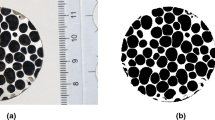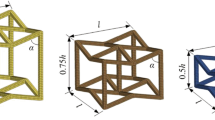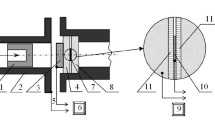Abstract
High-density aluminum foam can provide higher stiffness and absorb more energy during the impact Obtaining the constitutive law of such foam requires tri-axial tests with very high pressure, where difficulty may arise because the hydrostatic pressure can reach more than 30 MPa. In this paper, instead of using tri-axial tests, we proposed three easier tests—tension, compression and shear to obtain the parameters of constitutive model (the Deshpande–Fleck model). To verify the constitutive model both statically and dynamically, we carried out additional triaxial tests and direct impact tests, respectively. Based on the derived model, we performed finite element simulation to study the impact response of the present foam. By dimensional analysis, we proposed an empirical equation for a non-dimensional impact time \({\bar{t}}_{\mathrm {d}}\), the impact time divided by the time required for plastic wave travelling from the impact surface to the bottom surface, to determine the deformation characteristic of the aluminum foam after impact. For the case with \({\bar{t}}_{\mathrm {d}}\le 1\), the deformation tends to exhibit a shock-type characteristic, while for the case with \({\bar{t}}_{\mathrm {d}}>5\), the deformation tends to exhibit an upsetting-type characteristic.












Similar content being viewed by others
References
Gibson LJ, Ashby MF. Cellular solids : structure and properties. 2nd ed. Cambridge, New York: Cambridge University Press; 1997.
Gama BA, Bogetti TA, Fink BK, Yu CJ, Claar TD, Eifert HH, Gillespie JW. Aluminum foam integral armor: a new dimension in armor design. Compos Struct. 2001;52:381–95.
Amran YHM, Farzadnia N, Ali AAA. Properties and applications of foamed concrete; a review. Constr Build Mater. 2015;101:990–1005.
Ryan S, Christiansen EL. Hypervelocity impact testing of advanced materials and structures for micrometeoroid and orbital debris shielding. Acta Astronaut. 2013;83:216–31.
Deshpande VS, Fleck NA. Isotropic constitutive models for metallic foams. J Mech Phys Solids. 2000;48:1253–83.
Bastawros AF, Bart-Smith H, Evans AG. Experimental analysis of deformation mechanisms in a closed-cell aluminum alloy foam. J Mech Phys Solids. 2000;48:301–22.
Zhou ZW, Wang ZH, Zhao LM, Shu XF. Uniaxial and biaxial failure behaviors of aluminum alloy foams. Compos Part B Eng. 2014;61:340–9.
Zhu CF, Zheng ZJ, Wang SL, Zhao K, Yu JL. Modification and verification of the Deshpande-Fleck foam model: a variable ellipticity. Int J Mech Sci. 2019;151:331–42.
Reyes A, Hopperstad OS, Berstad T, Hanssen AG, Langseth M. Constitutive modeling of aluminum foam including fracture and statistical variation of density. Eur J Mech A Solids. 2003;22:815–35.
Hanssen AG, Hopperstad OS, Langseth M, Ilstad H. Validation of constitutive models applicable to aluminium foams. Int J Mech Sci. 2002;44:359–406.
Li QM, Mines RAW, Birch RS. The crush behaviour of Rohacell-51WF structural foam. Int J Solids Struct. 2000;37:6321–41.
Deshpande VS, Fleck NA. High strain rate compressive behaviour of aluminium alloy foams. Int J Impact Eng. 2000;24:277–98.
Hanssen AG, Reyes A, Hopperstad OS, Langseth M. Design and finite element simulations of aluminium foam-filled thin-walled tubes. Int J Veh Des. 2005;37:126–55.
Ayyagari RS, Vural M. Multiaxial yield surface of transversely isotropic foams: part I modeling. J Mech Phys Solids. 2015;74:49–67.
Shafiq M, Ayyagari RS, Ehaab M, Vural M. Multiaxial yield surface of transversely isotropic foams: part II-experimental. J Mech Phys Solids. 2015;76:224–36.
Shen JH, Lu GX, Ruan D, Seah CC. Lateral plastic collapse of sandwich tubes with metal foam core. Int J Mech Sci. 2015;91:99–109.
Shen JH, Lu GX, Ruan D. Compressive behaviour of closed-cell aluminium foams at high strain rates. Compos Part B Eng. 2010;41:678–85.
Xu SQ, Ruan D, Beynon JH, Lu GX. Experimental investigation of the dynamic behavior of aluminum foams. Mater Sci Forum. 2010;654–656:950–3.
Reid SR, Peng C. Dynamic uniaxial crushing of wood. Int J Impact Eng. 1997;19:531–70.
Barnes AT, Ravi-Chandar K, Kyriakides S, Gaitanaros S. Dynamic crushing of aluminum foams: part I—experiments. Int J Solids Struct. 2014;51:1631–45.
Gaitanaros S, Kyriakides S. Dynamic crushing of aluminum foams: part II—analysis. Int J Solids Struct. 2014;51:1646–61.
Tan PJ, Reid SR, Harrigan JJ, Zou Z, Li S. Dynamic compressive strength properties of aluminium foams. Part I—experimental data and observations. J Mech Phys Solids. 2005;53:2174–205.
Tan PJ, Reid SR, Harrigan JJ, Zou Z, Li S. Dynamic compressive strength properties of aluminium foams. Part II—‘shock’ theory and comparison with experimental data and numerical models. J Mech Phys Solids. 2005;53:2206–30.
Wang SL, Ding YY, Wang CF, Zheng ZJ, Yu JL. Dynamic material parameters of closed-cell foams under high-velocity impact. Int J Impact Eng. 2017;99:111–21.
Liu YJ, Qiang B. The stress–strain behaviors of high density aluminum foam under monotonic and cyclic loading. Intell Mater Mechatron. 2014;464:69–72.
Zhang XY, Tang LQ, Liu ZJ, Jiang ZY, Liu YP, Wu YD. Yield properties of closed-cell aluminum foam under triaxial loadings by a 3D Voronoi model. Mech Mater. 2017;104:73–84.
Wu YD, Qiao D, Tang LQ, Liu ZJ, Liu YP, Jiang ZY, Zhou LC. Global topology of yield surfaces of metallic foams in principal-stress space and principal-strain space studied by experiments and numerical simulations. Int J Mech Sci. 2017;134:562–75.
Wu YD, Qiao D, Tang LQ, Xi HF, Liu YP, Jiang ZY, Liu ZJ, Zhou LC. Global topology of failure surfaces of metallic foams in principal-stress space and principal-strain space studied by numerical simulations. Int J Mech Sci. 2019;151:551–62.
Yang CL, Kyriakides S. Continuum modeling of crushing of low density foams. J Mech Phys Solids. 2020;136:28.
Liu ZF, Hao WQ, Xie JM, Lu JS, Huang R, Wang ZH. Axial-impact buckling modes and energy absorption properties of thin-walled corrugated tubes with sinusoidal patterns. Thin Walled Struct. 2015;94:410–23.
Rawat S, Narayanan A, Upadhyay AK, Shukla KK. Multiobjective optimization of functionally corrugated tubes for improved crashworthiness under axial impact. Plast Impact Mech. 2017;173:1382–9.
Gurson AL. Continuum theory of ductile rupture by void nucleation and growth. 1. Yield criteria and flow rules for porous ductile media. J Eng Mater Technol Trans Asme. 1977;99:2–15.
Tvergaard V. Influence of voids on shear band instabilities under plane-strain conditions. Int J Fract. 1981;17:389–407.
Koplik J, Needleman A. Void growth and coalescence in porous plastic solids. Int J Solids Struct. 1988;24:835–53.
Benzerga AA, Leblond JB. Ductile fracture by void growth to coalescence. In: Aref H, Van Der Giessen E, editors. Advances in applied mechanics, vol. 44. San Diego: Elsevier Academic Press Inc; 2010. p. 169–305.
Lacroix R, Leblond JB, Perrin G. Numerical study and theoretical modelling of void growth in porous ductile materials subjected to cyclic loadings. Eur J Mech A Solids. 2016;55:100–9.
ABAQUS, ABAQUS Documentation, version 2016, Dassault Systèmes, 2016.
Zheng ZJ, Liu YD, Yu JL, Reid SR. Dynamic crushing of cellular materials: continuum-based wave models for the transitional and shock modes. Int J Impact Eng. 2012;42:66–79.
Acknowledgements
This work was supported by the National Natural Science Foundation of China (11772334, 11890681), the Youth Innovation Promotion Association CAS (2018022), and the Strategic Priority Research Program of the Chinese Academy of Sciences (No. XDB22040501).
Author information
Authors and Affiliations
Corresponding author
Rights and permissions
About this article
Cite this article
Peng, Q., Xie, J., Ma, H.S. et al. Dynamic Impact of High-Density Aluminum Foam. Acta Mech. Solida Sin. 35, 198–214 (2022). https://doi.org/10.1007/s10338-021-00256-6
Received:
Revised:
Accepted:
Published:
Issue Date:
DOI: https://doi.org/10.1007/s10338-021-00256-6




